555 people reached on Lassi with Lavina
265 views on LinkedIn – 4 Likes
Garba, Dandiya Raas and Navratri
An evergreen story from Lassi with Lavina’s archives
Can you garba? The story behind the popular festival of Navratri
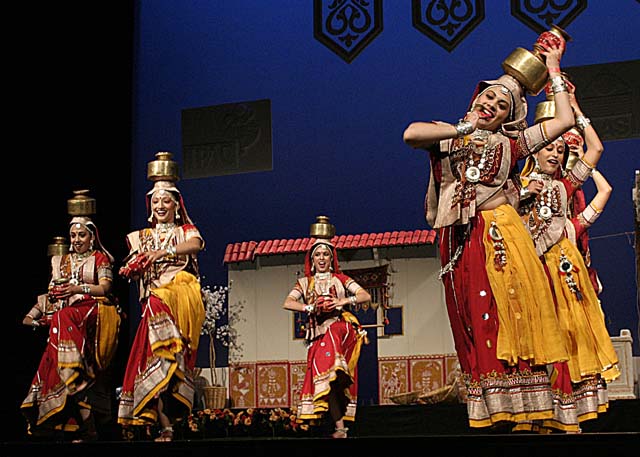
At Navratri, the Joy of Garba
With the upcoming holiday season begins the Indian community’s tryst with tradition in America. Both Garba and Dandiya Raas, folk dances, have found their way to America and everyone from heart surgeons to hip-hop kids are taking to the large dandiya raas arenas during the festival of Navrati which heralds a season of upcoming Hindu festivals from Dusshera to Diwali.
Garba is a religious and social event and harks back to the village traditions. “All social events that happen in the rural areas always have a ritualistic or religious significance,” says Smita Miki Patel, who is an educator in the folk arts of Gujarat, and has founded the India Performing Arts Center, a dance school in New Jersey. “Whether it’s the drawings on the walls of the huts, whether it’s the motifs you see on the women’s skirts – all of them have significance in their religious life and their vratas, the rituals they perform.”
Ask her why Garba is so important, and Patel, who came to the US from Bombay in 1981, says, “It’s very dear to all Gujaratis because it’s worship of the Goddess.”
Indeed, the word Garba is derived from the Sanskrit word Garbadeep, which means a light inside a pot and represents the Almighty shining through the perforations of the pot, which symbolizes the universe. The Garba tradition revolves around Shakti-Ma or Amba, the Mother Goddess in Hinduism, and garba or the clay pot also represents the womb and fertility. It’s a very meaningful ritual for females because it honors the Goddess and also their own ability for creation.
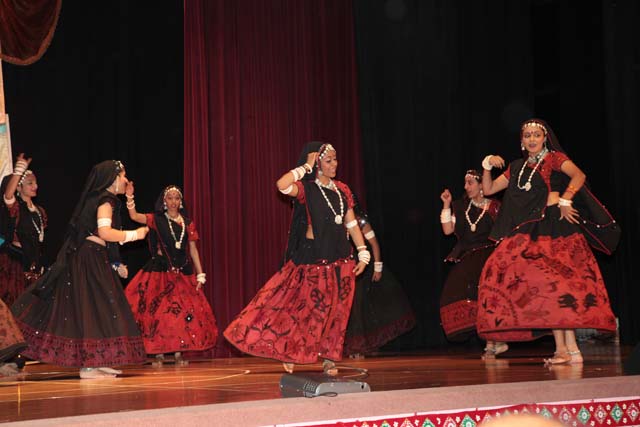
Garba & Dandiya Raas: Rituals and Romance
Garba is definitely a village dance and it’s a participatory type of folk art rather than something that is learned and taught and has tenets,” she says. “It is something young women grow up with and infuse it into their being and every time there is a celebration, that is what they perform.”
Garba, the state dance of Gujarat, dates back to the Vedic Shastras and its essence is that it has to be in a circle and there must be claps and clicks. It is a very ancient dance form and it’s still performed in the villages, the towns and the cities of India.
While the Garba is performed by women in a circle, singing and clapping rhythmically as they worship the Goddess Amba, in Dandiya Raas, both men and women participate, moving in two circles in clockwise and anti-clockwise directions, clicking dandiya or wooden sticks with changing partners.
Asked about the possibility of romantic connections being formed, Patel said, “It is becoming so in the modern world – and it was so before. Obviously the social interaction is different – in a rural area it may be from a distance, here the connection is much closer, and more.” Indeed, these events have become social icebreakers wherever Gujaratis live, be it in India, Africa, the U.S. or England.
Both Garba and Dandiya Raas have many variations, depending on regions and communities but the basics are always adhered to. The dance is at the heart of any celebration and no wedding or birth of a child in a Gujarati household would be complete without the guests breaking into Garba and Dandiya Raas, to the beat of drums.
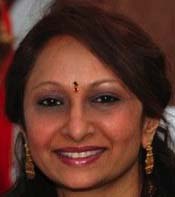
The biggest celebrations are during Navratri, and the revelries go on for 10 days. In India there are big Garba and Dandiya Raas parties in towns and cities, often with major dandiya performers joining in. Raas Garba performances and celebrations are held in many venues from huge catering places to high school auditoriums. Raas Garba has become big business and there are performers, dance teachers, drummers, costume designers and stores all catering to this big passion. The two folk dances are a must at sangeet parties thrown during Gujarati weddings and there are special Garba cards that are sent out on the occasion. These dances are now gaining new fans.
Garba – Changes in a New Landscape
So has this ancient dance changed in its journey over oceans and continents and does it still have relevance for the American born Gujarati children?
The Nartan Rang Dance School of Bharatiya Vidya Bhavan in New York has many students learning Raas Garba and their origins are from all parts of India. Swati Vaishnav, who is the Artistic Director, teaches folk dances, semi classical and movie dances at this school. She says, “It is very vigorous and kids enjoy the rhythm – Garba has varying rhythms – fast and slow – so it keeps the children very interested. It’s not only going in a circle all the time – they keep making different formations all the time. It makes it more creative.”
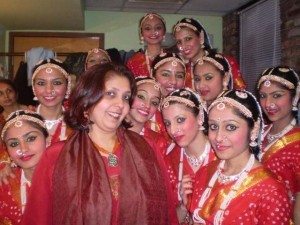
She says that while Garba has always been an all-women dance, here there’s an effort to get everyone involved and make it more interesting, so Garba and Dandiya Raas are sometimes combined together. In spite of the modifications, Vaishnav says, “I’m just happy these kind of activities are going on in this country to keep our children aware of our culture, and I hope all parents take interest and really send their children to learn all these different forms of dances and keep our culture alive.”
People are certainly getting involved because Vaishnav says the ages of her students go from four years of age to 45 years! She says, “They all started at young ages and have come back for repeat lessons because Fogana has a category for adults too, 30 and over. That’s the greatest thing they’ve done because there are so many people who are interested and this gives them an opportunity to continue.”
“In Fogana, folk arts are a way for us to reach our youngsters and make them proud of their heritage,” says Patel. “Because it’s something participatory and not something people lecture you on, you can partake of it and be social with it, and it becomes a very wonderful vehicle for us to pass on our culture to the next generation.”
Having been reared with Raas-Garba, most Gujarati children know it almost by osmosis. For them, it’s part of religious ritual and social interaction. This writer is constantly amazed at the grace and confidence with which even middle-aged and the elderly join in the ever-expanding circle at Gujarati weddings and other celebrations. They are performing for the Goddess, and there’s no self-consciousness or shyness.
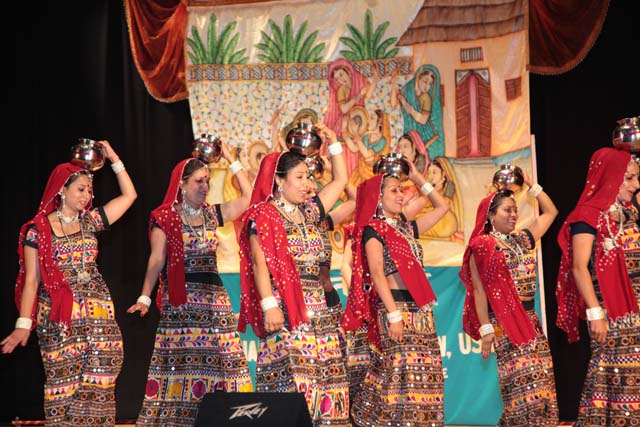
While the children are performing Garba and Dandiya, they are bringing their own changes and variations into this age-old dance, influenced by Bollywood, Indi pop and western music.
Today our youngsters in a western country and the influences are other music and disco, you will have Disco Garba and Disco Dandiya but traditionally it was not there,” says Patel. “We at Fogana believe that since folk art is not set in stone it is always a very lively thing that moves with the times, with the surrounding influences.”
Garba – Tradition and Transformation
Yet Fogana is committed to keeping the authenticity of the dances intact. In the competitions they do allow a little leeway because it’s a stage performance rather than a ritual. Dances in the garba may break the circle for choreographic purposes, but they must immediately go into another circle.
Patel says the dances have got modified over the years but at Fogana due to its commitment to the past, there are detailed rules and regulations for ensuring authentic performances. In the folk category competition, for instance, there has to be a maximum of two props, such as hankies, pots, tambourines or the dhol, because the dances are about the joys of working on farms, fields and on the road. She says, “We are definitely trying to preserve the extreme ethnicity of the oldest garba. We are trying our level best with the styles, the lyrics, the costumes as well as the steps of the garba.”
But that does not mean innovations are not happening. Disco Dandiya and Disco Garba have become very popular with young people and are all the rage at Navratri celebrations. The Raas Garba trend is moving from the Gujarati community to the larger Indian community and many Indian dance schools teach these folk dances along with those of Rajasthan, Maharashtra and the South. Indian dance schools are very popular with both Indian parents and children and there are hundreds across America.
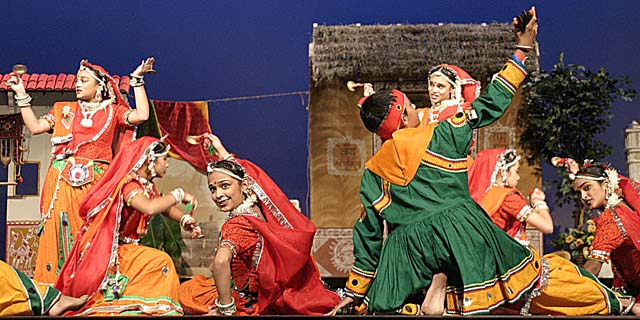
Indeed many colleges from Georgetown University to Rutgers to New York University have Raas Clubs and have major Garba contests. The Dandiya Raas, with its high energy and music is a great way for Indian-Americans to gather and enjoy their culture, especially with the disco beats. In these lively gatherings even non-Indians join in, learn to master the wooden sticks and have lots of laughs and fun.
While bhangra and garba raas are all folk dances, the Gujarati folk dances don’t seem to have crossed over as much as Bhangra. According to Vaishnav, Bhangra’s rhythm has become so powerful and prominent in this country because it combines east and west and young people enjoy that more. In Garba the western touch has not come in. Patel mentions Bhangra’s rise in London and the many remixes which have made it popular on the dance floor.
“Lately, these have become a meeting place for teenagers,” says Vaishnav of the Garba celebrations, bringing another aspect into the open. “Not everyone goes to the venue in nice ghaghra cholis and kurtas and just make it a meeting point to hang out instead.”
She does not like some of the changes time has wrought. “The change in music has really upset me. There is no more authentic Gujarati Garba – all of the singers have started singing filmy music and gone so far as to the extent of playing bhangra music at the Garba festival! That is something that should be changed and the singers should make sure to sing Gujarati Garbas at these events!”
She feels some children have lost interest in the dance competitions due to school work and other extracurricular activities. She says, “ Fogana competitions require a lot of practice and perfection for teams to be able to make it to the top and over the years, it has even become quite expensive to travel to Fogana’s national competitions.”
At the same time, she says Navratri has become one of the most popular festivals, not only amongst Gujaratis, but with other communities as well. “This is one religious festival where there is more physical action and interaction between the Garba dancers rather than just going to the temple and doing various pujas, where it becomes hard for kids to focus,” she says.
Garba Finds New Fans in America
As she points out, the Garba rhythm is very upbeat and moving. With India’s new prominence in the world and the explosion of the Indian population, Americans are also learning about these cultural traditions from Indian friends at work and at school.
Patel also agrees that it’s all a matter of exposure: Young people often get their ideas from the movies, and want to incorporate what they see in their own events and weddings. She points out that Bhangra is seen a lot more in Bollywood films which are viewed by one and all. “If we were to have 101 garba raas movies – I think you might see it more.”
Indeed, Garba Raas has entered into the consciousness of pop culture, from Salman Khan and Aishwarya playing dandiya raas in ‘Hum Dil De Chuke Sanam’ to the romantic duo in ‘Bride and Prejudice’ playing Dandiya Raas. Now more Gujarati and Rajasthani folk dances are being introduced into movie dance sequences by choreographers. Patel says even the rural, husky voice which one rarely heard before, is becoming popular in Bollywood movies.
Have things changed further in the last five years? Says Patel: “The dance form of Garba has definitely taken over the Indian youth of America. Just within five years, the high school and the university youth are conducting Garba competitions, and that’s not just Gujaratis but Indians in general as well as youngsters of other nationalities. They are dancing to the tunes of Garba Raas with ethnic and colorful chaniya choli costumes. I constantly get calls for good Garba music and the availability of costumes.”
Because of Garba’s popularity and Navratri celebrations, a lot of high school and university kids drag their friends for Garba and Dandiyas for the competition as well as Navratri, she says. During weddings there are sangeet and Garba Nights where American friends of bride and groom learn to wield the dandiya sticks. She says, “I have judged many competitions for youngsters in school, colleges as well as in Fogana and have witnessed whites, blacks, Spanish, Italians besides Indians dancing to the rhythm of Garba-Raas on the stage.”
These dances are so much more than social interaction. At the heart, Garba and Raas are about oneness with the Supreme Being, a religious experience. Adds Patel, “Dandiya Raas and Garba are performed at any celebration whether it is social or religious. The exuberance and the joy you feel inside always wants to make you dance.”
© Lavina Melwani
(This article was written in 2005 and was updated in 2010 with fresh conversations with Artistic Directors and Choreographers Swati Vaishnav and Smita Miki Patel.)
Related Article: Navratri – Goddess Power

4 Comments
That’s absolutely true!
S. Kaul via LinkedIn
It’s passion of love, connection of festivals to roots nurtured. It’s appreciable .
Thanks, Sonia! It’s even more beautiful seen live.
Beautiful!